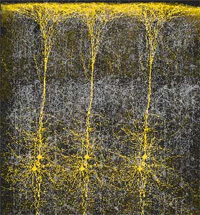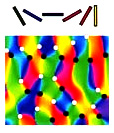 14) Neocortex is composed of columnar functional units (Mountcastle – 1957, Hubel & Wiesel – 1962)
14) Neocortex is composed of columnar functional units (Mountcastle – 1957, Hubel & Wiesel – 1962)
Mountcastle found that nearby neurons in monkey somatosensory cortex tend to activate for similar sensory experiences. For example, a neuron might respond best to a vibration of the right index finger tip, while a neuron slightly deeper in might respond best to a vibration of the middle of that finger.
The neurons with these similar 'receptive fields' are organized vertically in cortical columns. Mountcastle distinguished between mini-columns, the basic functional unit of cortex, and hyper-columns, which are functional aggregates of about 100 mini-columns.
Hubel & Wiesel expanded Mountcastle's findings to visual cortex, discovering mini-columns showing line orientation selectivity and hyper-columns showing ocular dominance (i.e., receptive fields for one eye and not the other). The figure below illustrates a typical spatial organization of orientation columns in occipital cortex (viewed from above), along with the line orientations corresponding to each color patch.
Implication: The mind, largely governed by reward-seeking behavior, is implemented in an electro-chemical organ with distributed and modular function consisting of excitatory and inhibitory neurons communicating via ion-induced action potentials over convergent and divergent synaptic connections strengthened by correlated activity. The cortex, a part of that organ composed of functional column units whose spatial dedication determines representational resolution, is involved in perception (e.g., touch: parietal lobe, vision: occipital lobe), action (e.g., frontal lobe), and memory (e.g., temporal lobe).

[This post is part of a series chronicling history's top brain computation insights (see the first of the series for a detailed description). See the history category archive to see all of the entries.]
-MC

Leave a comment